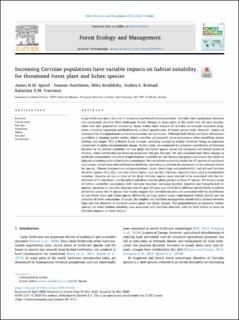| dc.contributor.author | Speed, James David Mervyn | |
| dc.contributor.author | Austrheim, Gunnar | |
| dc.contributor.author | Bendiksby, Mika | |
| dc.contributor.author | Kolstad, Anders Lorentzen | |
| dc.contributor.author | Vuorinen, Katariina | |
| dc.date.accessioned | 2020-09-29T08:22:19Z | |
| dc.date.available | 2020-09-29T08:22:19Z | |
| dc.date.created | 2020-09-11T10:34:40Z | |
| dc.date.issued | 2020 | |
| dc.identifier.citation | Forest Ecology and Management. 2020, 473, | en_US |
| dc.identifier.issn | 0378-1127 | |
| dc.identifier.uri | https://hdl.handle.net/11250/2680153 | |
| dc.description.abstract | Large herbivores play a key role in temperate and boreal forest ecosystems. Cervidae (deer) population densities and community structure have undergone drastic changes in many parts of the world over the past decades, often with deer populations increasing. Many studies show impacts of Cervidae on multiple ecosystem properties, including vegetation and biodiversity, at local spatial scales. At larger spatial scales, however, impacts of changing Cervidae populations on forest ecosystems are less known. Although both abiotic and biotic dimensions contribute to shaping species’ niches, abiotic variables are generally given prominence when modelling species habitats and ranges. This is despite biotic changes, including changes in trophic structure, being an important component of global environmental change. In this study, we examined the potential contribution of Cervidae densities to the habitat suitability for rare plant and lichen species across the temperate and boreal forests of Norway, where cervid densities have increased over the past 60 years. We also examined how these changes in herbivore communities may have shaped habitat suitability for rare lichens and plants and discuss the results in light of continuing shifts in herbivore assemblages. We ran habitat suitability models for 47 species of rare plants and lichens, which were selected based on herbivory reported as a criterion for placement on the national red list for species. Climate (temperature and precipitation), forest (forest type and productivity), soil pH and Cervidae densities (moose Alces alces, red deer Cervus elaphus and roe deer Capreolus capreolus) were used as independent variables. Densities of one or more of the three Cervidae species were inferred to be associated with the distribution of 14 (ten lichen, one bryophyte and three vascular plant species) of these 47 species. We found a range of habitat suitability associations with Cervidae densities, including positive, negative and hump-backed responses. Increases in Cervidae densities over the past 60 years may have led to different spatial trends in habitat suitability across the 14 species. Our results suggest that Cervidae densities are associated with the distribution of rare forest plant and lichen species differently at large spatial scales; experimental studies should test the causality of these associations. If causal, this implies that Cervidae management should find a balance between high and low densities to conserve several plant and lichen species. The preponderance of epiphytic lichens species, for which habitat suitability was associated with Cervidae densities, calls for field studies to focus on Cervidae impacts on forest lichens. | en_US |
| dc.language.iso | eng | en_US |
| dc.publisher | Elsevier | en_US |
| dc.rights | Navngivelse 4.0 Internasjonal | * |
| dc.rights.uri | http://creativecommons.org/licenses/by/4.0/deed.no | * |
| dc.title | Increasing Cervidae populations have variable impacts on habitat suitability for threatened forest plant and lichen species | en_US |
| dc.type | Peer reviewed | en_US |
| dc.type | Journal article | en_US |
| dc.description.version | publishedVersion | en_US |
| dc.source.volume | 473 | en_US |
| dc.source.journal | Forest Ecology and Management | en_US |
| dc.identifier.doi | https://doi.org/10.1016/j.foreco.2020.118286 | |
| dc.identifier.cristin | 1828981 | |
| dc.relation.project | Norges forskningsråd: 262064 | en_US |
| dc.description.localcode | This is an open access article distributed under the terms of the Creative Commons CC-BY license, which permits unrestricted use, distribution, and reproduction in any medium, provided the original work is properly cited. | en_US |
| cristin.ispublished | true | |
| cristin.fulltext | original | |
| cristin.qualitycode | 1 | |

